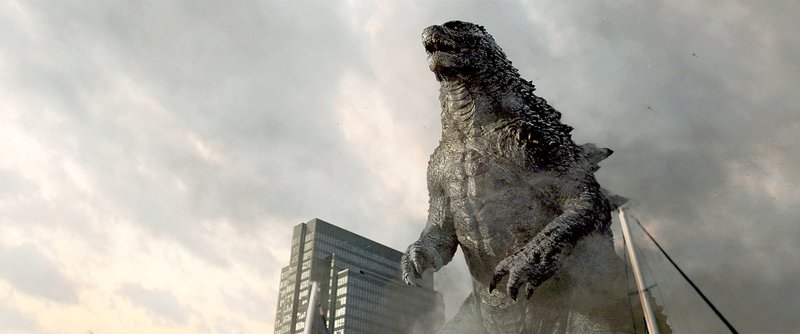Back in 1998, director Roland Emmerich, who, some years before had produced the idiotic but wildly popular Independence Day, brought a much reviled Godzilla remake to the screen. Universally panned by critics and filmgoers alike, Emmerich's shabby effort barely broke even after its first huge box-office weekend. Dumb, dull and, worst of all, unfaithful to the spirit of the original series, it left 'Zilla heads glowering in radioactive fury. Now, some decade and a half later, Warner Bros. has seen fit to give it another crack.
It sounds peculiar to say about a film whose protagonist is a 350-foot ancient alpha predator with pointed back fins and radioactive flame breath, but the first hour of Gareth Edwards' big-budget remake shows admirable restraint. Taking a cue from classic monster flicks (including, of course, Jaws), the filmmaker chooses not to reveal his scaly hero at first, only alluding to him by giant, craterous exo-skeletons and tasty, pristine cityscapes in Japan and the U.S., waiting for their inevitable destruction.
Godzilla
87 Cast: Bryan Cranston, Aaron Taylor-Johnson, Ken Watanabe, Elizabeth Olsen, Carson Bolde
Director: Gareth Edwards
Rating: PG-13, for intense sequences of destruction, mayhem and creature violence
Running time: 123 minutes
This turns out to be a good thing, because when the big fella is finally revealed -- and rest easy, 'Zilla fans, he is more or less fully restored to his former glory, after Emmerich's disastrous attempt to turn him into a giant lizard back in '98 -- he looks very much like a souped-up CGI version of the silly man-in-suit from the original '50s Japanese films. Albeit with slightly more child-bearing-looking hips.
The plot is pretty nonsensical. We begin in Japan in 1999. There, Dr. Brody (Bryan Cranston), an American scientist in charge of the small port city's nuclear facility, watches in horror as a devastating, unexplained disruption wreaks havoc on the plant and causes his wife's death, leaving him and his young son, Ford, on their own. Jump ahead to the present and Ford (Aaron Taylor-Johnson) has grown into a square-jawed Navy lieutenant whose specialty is deprogramming bombs (a useful skill that the film absolutely telegraphs will become a factor later on), with a beautiful wife (Elizabeth Olsen) and young son (Carson Bolde) waiting for him in San Francisco.
Returning to Japan to rescue his father from the Japanese authorities -- forlorn and half-mad, his father remains convinced that the plant's "natural" disaster was anything but -- the pair are uneasily reunited just in time for things to go horribly wrong. It turns out Brody's theory is all too true as they discover what the government has been hiding all this time: an enormous hatching pod for an enormous, supremely powerful insectlike creature (though never officially named, it's closest in comparison to Godzilla's most venerable foe, Mothra).
Naturally, it hatches in front of their eyes and suddenly there's a 200-foot flat-headed flying arthropod roaming the skies in search of its much larger mother. Before we know it, word (noise?) of the creature's appearance puts Godzilla on notice, acting on nature's behalf to "restore balance," in the words of Dr. Serizawa (Ken Watanabe), one of the initial scientists studying the creature (though nature apparently has no problem with mankind disrupting and disharmonizing everything in its path). Godzilla flies to the aid of the Japanese port, and we can assume some sort of battle takes place.
We have to assume that because, for reasons a bit less understandable than the film's initial restraint, Edwards and his production team keep turning away from these skirmishes, suddenly jump-cutting us into a new scene (later in the film, massive doors close out our view just as Godzilla is about to do further combat). Admittedly, when we do get to see these epic battles much closer to the end of the film, they take on the silly ponderance of a cartoon, but that is, after all, what most people are laying down their shekels to see in a Godzilla flick.
To be fair, the film's producers were put in a bit of a tight spot: wanting to take the project seriously while staying as true to the Heisei version of the creature as possible, while still trying to update its cachet (and message) in the process. It's not an easy mandate. They've at least succeeded in making a Godzilla film that follows the basic conventions of the genre. You have your fearsome Godzilla roars (as signature an utterance as a James Brown "unh!") and potent flame breath, and you have a bunch of monsters duking it out over the teeming streets of major international cities. What more do you need?
Despite its studious updating, though, the essential story is every bit as silly as the original. We get to watch grown men like David Strathairn have to enact plot points that feel dreamed up by a slew of 9-year-olds. "Let them fight!" Serizawa growls at a military commander, as if that's the only way this thing is ever going to get resolved.
If the original films were Japan's cinematic answer to the nuclear disaster that was Hiroshima and Nagasaki -- in those films, Godzilla was awakened by all the atomic bomb testing in the region and went on to devastate Tokyo, much in the manner of destruction the Allies brought to their doorstep -- this version purports 'Zilla to be the cities' defender. He's a massive bodyguard brought in to roust the insectoid patrons who have grown a bit too rowdy and haul them out into the streets for a beatdown they'll never forget. Forget restoring nature's teetering balance, Godzilla is Patrick Swayze's character from Road House with blue atomic fire breath in place of pithy aphorisms.
MovieStyle on 05/16/2014
